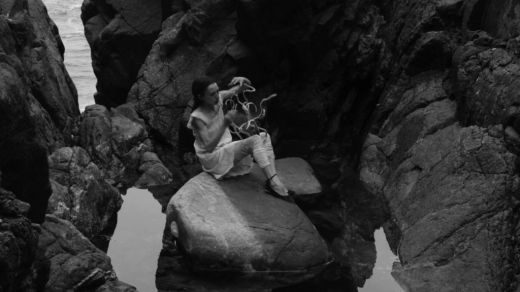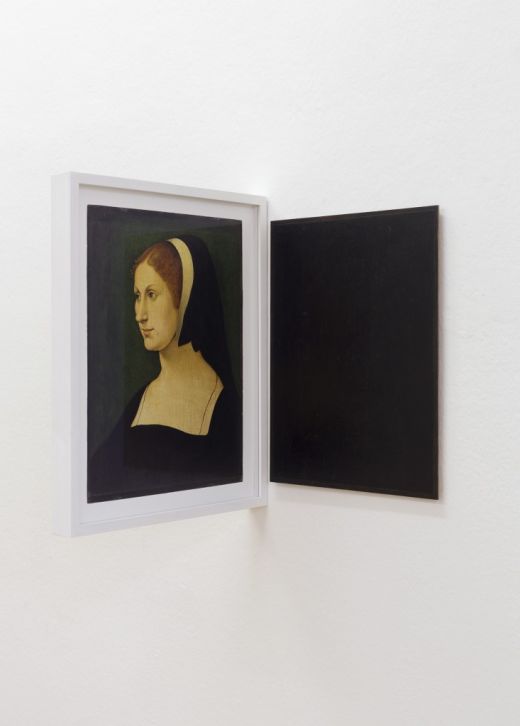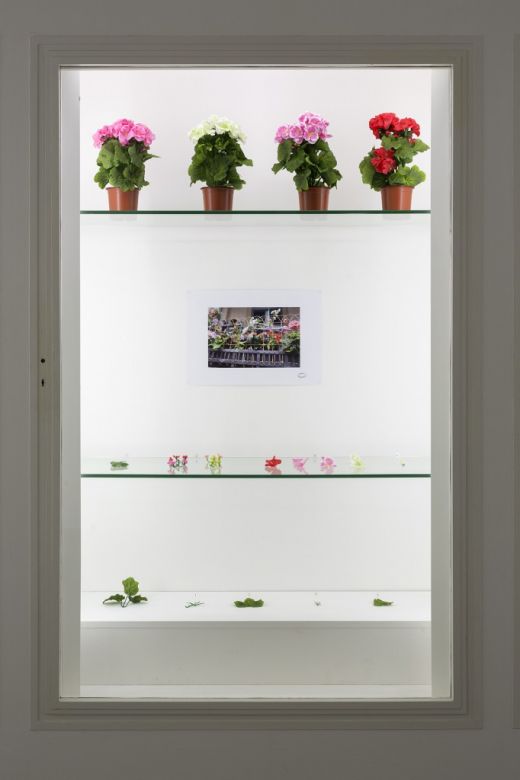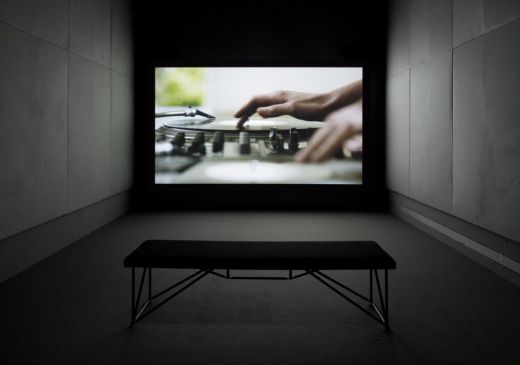- My Journey With Aeroflot: Adventures in the Estonian Contemporary Art World

- Yann Gerstberger, SURFBOARD
Berlin Biennale 8
Ombretta Agró Andruff

Carlos Amorales, The Man Who Did All Things Forbidden, 2014. HD-Video, sound, 40’. Courtesy Carlos Amorales; Galerie Yvon Lambert, Paris; kurimanzutto, Mexico City.
The Biennale was established in 1996 by Klaus Biesenbach, founding director of Kunst-Werke Institute for Contemporary Art (KW), and a group of collectors and patrons. This edition’s director was the Canadian-born Juan A. Gaitán. Like his predecessors, the curator was invited to live in Berlin for several months while working on the show, residing within the KW complex. From there he assembled an eclectic Artistic Team, including Lebanese-born and Paris-based sound artist and composer Tarek Atoui, Berlin-based curator and writer Natasha Ginwala, Colombian curator Catalina Lozano, Mariana Munguía, a Mexico City-based sociologist and art manager, Berlin-based artist Olaf Nicolai, and Vietnamese artist Danh Vo.
This year’s Biennale brought together 54 international artists, many of them with cultural backgrounds that extends beyond Europe, and whose practices are situated between larger historical narratives and individual lives. The majority of the artists were commissioned to produce new works for the exhibition spanning all type of media, in many cases exploring colonial traces in our global present. There was a conspicuous presence of drawing-based practices and a significant emphasis on sound and composition.

Matts Leiderstam, Kat. Nr. S.19 (Unknown Unknown), 2014. Installation at the Gemäldegalerie, Staatliche Museen zu Berlin. Courtesy Matts Leiderstam; Andréhn-Schiptjenko, Stockholm© Matts Leiderstam / VG Bild-Kunst, Bonn 2014 Photo: Anders Sune Berg.
This year’s Biennale extended over three main buildings. Besides KW in Mitte’s heart, Gaitán selected two venues in the city’s southwestern neighborhood of Zehlendorf. The first, Haus am Waldsee, is a country-style villa built in 1922 for a wealthy Jewish textile producer, set in a bucolic park facing the Waldsee lake. In 1945 it became one of the first venues dedicated to visual and performing arts in West Berlin. Since 2004 it has been used to showcase contemporary art exhibitions. Of the seven artists/collectives on display, three struck a chord.
Patrick Alan Banfield is a young German artist working with time-based media. He presented a mesmerizing two-channel video and sound installation, “vyLö:t” (2012). Two screens face each other. On one, the viewer looks at stunning forest vista in the Taunus mountain, north of Frankfurt; on the other: long tracking shots of concrete housing blocks with menacing façades. Banfield brings to the fore the timeless dichotomy between the natural and the built environment. While the visuals provided a dramatic setting, it was the soundtrack—a collaboration between the artist and Sascha Blank—that made the video so compelling. On the second floor was a beautiful and elegant installation by Matts Leiderstam, a Swedish artist who works with art history, its materials, and its circulation. For this project, “The Connoisseur’s Eye,” Leiderstam photographed paintings (both front and back) from the Nationalmuseum Image Archive in Stockholm and the Gemäldegalerie in Berlin and hung the prints in two consecutive rooms presented in a way that both the front of the painting and the back of the stretcher would be visible, thus giving the same prominence to the actual image as to the part that is usually hidden from public view.
Slavs and Tatars, a collective whose work investigates geopolitical and historical transformations in the aftermath of 20th century Communism and the development of political Islam, presented “Ezan Çilginnnnnlari” (2014). The work is a sound piece that references the controversy surrounding a law requiring the translation of the Islamic call to prayer from Arabic to Turkish, enforced for nearly two decades until 1950. It looked like a giant open book embedded in the grounds of the park, near the water, with implanted oversize speakers through which the audience could listen to a recording of the Turkish ezan produced by a computer speech mechanism.
Just a short u-bahn ride from Haus am Waldsee was the Museen Dahlem-Staatliche Museen zu Berlin, home to significant ethnological collections of objects and artifacts from Africa, the Americas, Australia, and Oceania. The selection of the venues is a result of Gaitán’s observation of the ability of Berlin to develop in interesting ways, “both in terms of what the city has become, and how this process reflects a larger tendency around the world to mobilize history in order to reinforce the hegemony of certain dominant narratives” as the curator writes in the catalogue. Taking Berlin as a starting point, while not losing sight of the world at large, Gaitán is underlining the “tendency to move history onto the center stage and to disavow the last century.” Haus am Waldsee and Museen Dahlen, both situated in the West, were important cultural hubs at the beginning of the 20th century, but became peripheral in the aftermath of the Second World War. Kunst-Werke, traditionally the main Berlin Biennale venue and one of the epicenters of the city’s cultural renaissance since the mid-’90s, now must compete with its position of centrality. The Museen Dahlem was founded in 1873; construction of the current site started in 1914 and was completed in 1964 with the opening of the museum complex as it stands to this day. Installing their works in these very peculiar settings provided the ideal ground for the artists to engage in a creative dialogue with their surroundings. Furthermore, the challenge of finding the Biennale’s works scattered throughout the four floors of the building, while at times frustrating, allowed visitors to explore the museum’s collection. My foray into the Micronesian rooms left me absolutely mesmerized by an installation of several Micronesian boats from the turn of the 20th century.
Past the information desk, Olaf Nicolai’s floor installation “Szondi/Eden” welcomes visitors. The geometric pattern was inspired by the decorative tile inlay from the interior of a vacant mall in Lichtenberg. On the floor stood four large lamps, turning the lobby of the museum in a weird indoor-outdoor plaza.
In the basement, the repetitive sound of percussions announced Mexican Mario García Torres’s installation “Sounds Like Isolation to Me,” a museographical investigation of the life and work of Mexican composer Conlon Nancarrow. The fascinating installation was punctuated by original artifacts such as John Cage drawing on Japanese paper from 1987, his musical sheet for the iconic 4’33” piece, letters between Cage and Nancarrow, and a copy of Lucio Fontana’s “Manifesto Blanco” from 1946. All this was surrounded by a hypnotic score composed by Nils Frohm and based on rescued tapes from Nancarrow’s studio.

Alberto Baraya, Expedition Berlín, Herbarium of Artificial Plants, 2013-. Mixed media, Dimensions variable. Installation view Courtesy Alberto Baraya; Galeria Nara Roesler, São Paulo. Photo: Anders Sune Berg.
Other artists featured on the ground floor presented a series of video and film-based works quite different in styles and settings. Pakistani Bani Abidi presented “Karachi Series II” (2014), a touching meditation on the cosmopolitan history of Karachi including six videos as well as photographs; Italian Rosa Barba’s “Subconscious Society” (2014), an abstract account of the end of the industrial era and the rise of the digital one, was developed through a film that poetically alternates views of a number of natural landscapes, from the coast of Kent to the desert of Marfa, to the interiors of an abandoned powerhouse and textile center. Last, as a grand conclusion to the ground floor, stood Albanian Anri Sala’s film installation “Ravel Ravel Unravel” (2013) in which DJ Chloé is portrayed while attempting to mix two versions of a recording of a Ravel piano concerto. Close-ups of the DJ’s hands, intent eyes, and the mesmerizing soundtrack captivated an audience that often stayed, as I did, for the full length of the film.
The first work that appeared on the upper floor was a stage set created by Polish artist Goshka Macuga for her play Preparatory Notes for a Chicago Comedy (2014). As is the case of much of her practice, the play draws from the work of art historian Aby Warburg (1866-1929), in particular a play he wrote for a family gathering in 1896. Just past Macuga’s set, UK-born and Lahore-based artist David Chalmers Alesworth exhibited a combination of delicate watercolors, “Trees of Pakistan” (2013-14), miniatures of trees from Lahore and Karachi, along with two traditional hand-woven rugs embroidered with street maps, one of them a copy of an 1862 map of Stanford. The only project on the second floor, hard to find but well worth the effort, consisted of two rooms; “Double Lives” by Natasha Ginwala showcased drawings, treaties and other artifacts created by a series of 19th century characters whose lives straddled the line between art and science.

Anri Sala, Unravel, 2013. HD video, color, sound discrete 4.0, 20:45 min. Installation view. Courtesy Anri Sala; Galerie Chantal Crousel, Paris; Marian Goodman Gallery, New York / Paris; Hauser & Wirth, London/ New York/Zurich; kurimanzutto, Mexico City © Anri Sala / VG Bild-Kunst, Bonn 2014. Photo: Anders Sune Berg.
After having visited the Biennale’s venues multiple times, what most stood out was the depth, rigor, and wide range of the research that clearly went into its planning. Having worked a lot in India, I was extremely pleased to see a considerable contingent of artists from India and Pakistan, including names that fall outside of the restricted group that often find its way onto the Biennials circuits. Some of these artists I knew (like Bani Abidi and Shilpa Gupta), while others were new and exciting discoveries (like David Chalmers Alesworth).
Most works in the exhibition embodied a compelling balance of a strong conceptual content, which was expressed using visually appealing and engaging methodologies. Certainly the fact that most artists created works specifically for the occasion helped make the show cohesive while it showcased works embracing a wide variety of media by artists with very unique and diverse practices. The relatively small number of artists, the size of the hosting venues, and the amount of space allocated to each project made it easy for the viewer to focus on the individual works and fully take in and appreciate the many layers that constituted each.









